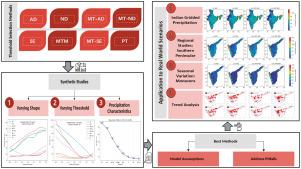用于模拟印度次大陆极端降水的广义帕累托分布自动阈值选择方法的定量评估
IF 6.3
1区 地球科学
Q1 ENGINEERING, CIVIL
引用次数: 0
摘要
极值理论(Extreme Value Theory, EVT)为模拟和理解极端事件的行为提供了可靠的统计框架。在EVT中,峰值-超阈值(POT)模型是估计极端降水事件(EPEs)的有效方法;然而,它的应用很大程度上受到了选择最佳阈值的挑战。本研究在广义帕累托分布(GPD)模型的背景下,批判性地检验和比较了几种阈值选择方法的理论基础(如Anderson Darling (AD)、差异正态性(ND)、平方误差(SE)和多阈值法(MTM))。这些方法的比较是在i)通过蒙特卡罗模拟生成的合成数据集和ii)来自印度次大陆的日和季节网格降水数据集上进行的。该评价揭示了现有方法的一定理论局限性,从而导致了混合阈值选择方法的发展。合成样品的结果也表明,混合方法在确定临界阈值范围方面更为准确和有效。将该方法应用于印度降水数据集得到了可比较的结果,其阈值有效捕获了极端事件的空间格局,与区域特征一致。例如,沿海和东北部地区确定的阈值通常超过160毫米/天,而拉贾斯坦邦地区的阈值明显较低,通常小于15毫米/天。这些估计的阈值随后被用于研究印度地区极端事件的时间变异性。结果表明,在印度南半岛地区的某些地区,降水事件的峰值数量和峰值强度都有相当大的增加。这项研究对于提供全面的指导方针和提高基于pot的阈值选择方法识别EPEs的可靠性至关重要。该方法对于评估与气候变化有关的极端降水的强度和频率日益增加至关重要,为有针对性的缓解和减少灾害风险战略提供了宝贵的见解。本文章由计算机程序翻译,如有差异,请以英文原文为准。

Quantitative assessment of automated threshold selection methods for Generalized Pareto Distribution for modeling precipitation extremes in the Indian subcontinent
Extreme Value Theory (EVT) provides a reliable statistical framework for modeling and understanding the behavior of extreme events. Within EVT, the Peak-Over-Threshold (POT) model is a powerful method for estimating the Extreme Precipitation Events (EPEs); however, its application is limited largely due to the challenges in selecting optimal threshold values. The present study critically examines and compares the theoretical underpinnings of several threshold selection methods (such as Anderson Darling (AD), Normality of Differences (ND), Squared Error(SE) and Multiple Threshold Method (MTM)) within the context of the Generalized Pareto Distribution (GPD) model. The comparison of these methods was performed on i) synthetic datasets generated through Monte Carlo simulation and ii) daily and seasonal gridded precipitation datasets from the Indian subcontinent. The evaluation revealed certain theoretical limitations of the existing methods, leading to the development of hybrid threshold selection methods. Results from the synthetic samples also show that the hybrid methods are more accurate and effective in determining critical threshold ranges. Application of the method to Indian precipitation datasets yielded comparable results, with threshold values effectively capturing the spatial pattern of extremes, consistent with regional characteristics. For example, thresholds identified for coastal and northeastern regions often exceed 160 mm/day, while the Rajasthan region exhibits significantly lower thresholds, frequently less than 15 mm/day. These estimated threshold values were subsequently employed to investigate the temporal variability of extreme events within the Indian region. The results indicated a considerable increase in the number of peaks and peak intensity of precipitation events in certain parts of the Southern Peninsular region of India. This study is crucial for providing comprehensive guidelines and improving the reliability of POT-based threshold selection methods for identifying EPEs. The approach is essential for assessing the increasing intensity and frequency of precipitation extremes related to climate change, offering valuable insights for targeted mitigation and disaster risk reduction strategies.
求助全文
通过发布文献求助,成功后即可免费获取论文全文。
去求助
来源期刊

Journal of Hydrology
地学-地球科学综合
CiteScore
11.00
自引率
12.50%
发文量
1309
审稿时长
7.5 months
期刊介绍:
The Journal of Hydrology publishes original research papers and comprehensive reviews in all the subfields of the hydrological sciences including water based management and policy issues that impact on economics and society. These comprise, but are not limited to the physical, chemical, biogeochemical, stochastic and systems aspects of surface and groundwater hydrology, hydrometeorology and hydrogeology. Relevant topics incorporating the insights and methodologies of disciplines such as climatology, water resource systems, hydraulics, agrohydrology, geomorphology, soil science, instrumentation and remote sensing, civil and environmental engineering are included. Social science perspectives on hydrological problems such as resource and ecological economics, environmental sociology, psychology and behavioural science, management and policy analysis are also invited. Multi-and interdisciplinary analyses of hydrological problems are within scope. The science published in the Journal of Hydrology is relevant to catchment scales rather than exclusively to a local scale or site.
 求助内容:
求助内容: 应助结果提醒方式:
应助结果提醒方式:


